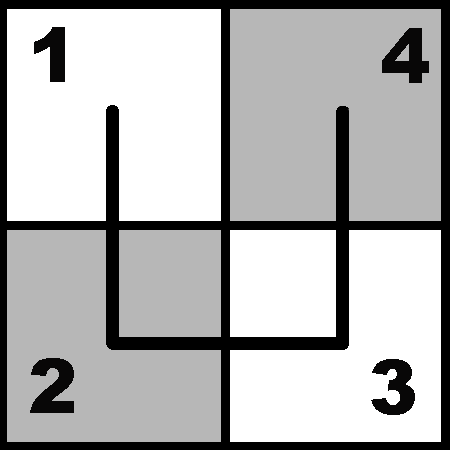Reservoir Dogs
Comprehensive Storyform
The following analysis reveals a comprehensive look at the Storyform for Reservoir Dogs. Unlike most of the analysis found here—which simply lists the unique individual story appreciations—this in-depth study details the actual encoding for each structural item. This also means it has been incorporated into the Dramatica Story Expert application itself as an easily referenced contextual example.
Story Dynamics
8 of the 12 essential questions
- Steadfast
- Main Character Resolve
Mr. White refuses to believe that Mr. Orange is the “rat,” even when all evidence points to him. When Mr. Orange confesses to him, he is anguished over the betrayal but remains true to his criminal nature and shoots him, at the cost of his own life.
- Stop
- Main Character Growth
Mr. White must stop believing his own (faulty) instincts.
- Do-er
- Main Character Approach
When the cops close in on Mr. White, he empties both guns into them rather than figuring a way to escape the conflict. He pulls his gun on Mr. Blond instead of arguing with him. He forces a shoot-out with Joe and Mr. Nice rather than re-evaluate his beliefs about Mr. Orange.
- Male
- Main Character Mental Sex
When Mr. White is confronted with a problem, his solution is to pull out his gun and eliminate the cause. He comforts the injured Mr. Orange by telling him not to worry, “it takes days to bleed to death” from gunshots to the stomach.
- Decision
- Story Driver
Joe decides to form a gang to pull the heist; Mr. Orange chooses to go undercover; Mr. Nice allows Mr. Blond to stay in the warehouse with the kidnapped cop. At film’s end, Mr. Orange decides to confess to Mr. White, who decides to kill him rather than giving himself up to the police.
- Optionlock
- Story Limit
Although Mr. Pink wants to go to a motel and Mr. Orange wants to be dropped off at a hospital, the robbers must wait at the warehouse for the arrival of their boss, Joe. In the search for the informant, various members of the group are eliminated as suspects; when Joe arrives, he narrows it down to one—Mr. Orange—and forces a showdown.
- Failure
- Story Outcome
The robbers fail to escape with the diamonds; the undercover cop has apprehended the gang but is finished off when he identifies himself as the “rat.” Everyone dies a violent death.
- Bad
- Story Judgment
Mr. White defends Mr. Orange’s honor and his life in a three-way shoot-out with his colleagues. He suffers intense anguish when he learns Mr. Orange betrayed him; in killing Mr. Orange, he seals his own fate.
Overall Story Throughline
""Uncovering the Rat""
- Physics
- Overall Story Throughline
The story in Reservoir Dogs revolves around a jewelry heist. When the robbery is bungled, the “colored men” endeavor to find out who the “rat” is.
- Obtaining
- Overall Story Concern
The robbers want their cut of the diamond heist and to escape capture by the police; the undercover cop, Mr. Orange, wants to apprehend the criminals and recover the loot.
- Self-Interest
- Overall Story Issue
Each of the robbers is out for themselves. As Mr. Pink says to Mr. White, “I don’t want to know your name.” Mr. Pink talks about himself incessantly, and feels it’s safer for him to leave the warehouse and go to a motel. The robbers gun down anybody who impedes their escape, whether they be police officers, an innocent motorist, or employees who ring the alarm.
- Morality
- Overall Story Counterpoint
- Overall Story Thematic Conflict
Self-Interest vs.Morality - Pursuit
- Overall Story Problem
The robbers are pursuing the identity of the “rat.” The cops are pursuing the robbers.
- Avoid
- Overall Story Solution
Avoiding the cops and their informant will allow the robbers to escape; avoiding discovery by the robbers will keep Mr. Orange’s plan to capture them on target.
- Control
- Overall Story Symptom
Despite the fact they have bungled the heist, the robbers remain true to Joe’s plan and meet at the warehouse to wait for him. Under torturous conditions, the uniformed cop exercises self-control and refuses to divulge the identity of Mr. Orange.
- Uncontrolled
- Overall Story Response
Mr. Blond runs amok at the site of the heist and again at the warehouse; Mr. Pink’s instincts are not to wait for Joe but rather to hightail it to a motel; against explicit orders, Mr. White gives his real name to Mr. Orange.
- Morality
- Overall Story Catalyst
After Mr. Orange kills Mr. Blond to protect the uniformed cop, he has trouble justifying his action to the other robbers and becomes the main suspect as the “rat.”
- Preconception
- Overall Story Inhibitor
Because of Joe’s rigorous screening process, it takes awhile for the robbers to accept that one of them is a “rat.”
- Understanding
- Overall Story Benchmark
The robbers struggle to understand who the “rat” is and how much the cops know. To infiltrate the gang, Mr. Orange must understand their methods and appreciate their belief in honor amongst thieves.
Additional Overall Story Information →
Main Character Throughline
Mr. White — Criminal
- Universe
- Main Character Throughline
Mr. White is in a situation, caught between the group he belongs to and the individual with whom he has become attached. As the song says, “I’m stuck here in the middle with you.”
- Future
- Main Character Concern
Mr. White is concerned with not going to jail.
- Preconception
- Main Character Issue
Mr. White holds onto his positive evaluation of Mr. Orange, and refuses to listen to his colleagues’ logical argument that he is the “rat.”
- Openness
- Main Character Counterpoint
- Main Character Thematic Conflict
Preconception vs.Openness - Help
- Main Character Problem
Mr. White’s responsibility to help the injured Mr. Orange pits him against his colleagues. He inadvertently helps Mr. Orange’s endeavor as an undercover cop by killing his colleagues, but is distraught when he learns he has helped the cops effect his own downfall.
- Hinder
- Main Character Solution
In order to avoid jail, Mr. White should be hindering the “rat,” not helping him.
- Control
- Main Character Symptom
In the restaurant, Mr. White takes the address book from Joe and tries to impose conditions for its return. He also tries to take control of the situation in the warehouse and get Mr. Orange to a hospital, but Mr. Pink insists they wait for Joe, the man in charge.
- Uncontrolled
- Main Character Response
In a confrontation with Mr. Blond, Mr. White loses control and pulls out his gun. In an effort to go along with the program, Mr. White leaves the warehouse with Mr. Nice and Mr. Pink; this allows the out of control Mr. Blond to torture the cop.
- Choice
- Main Character Unique Ability
Mr. White’s decision to back up Mr. Orange rather than believe Joe triggers the story’s climax. If he had made the correct choice by not supporting Mr. Orange, there would have been more opportunity to achieve the story goal.
- Attitude
- Main Character Critical Flaw
Mr. White’s overbearing attitude alienates him from his colleagues, especially as he’s just another “employee,” not the boss. He threatens, “If you dream of shooting me, you’d better wake up and apologize.” Mr. Blond snidely says to him, “I bet you’re a big Lee Marvin fan, aren’t you. Yeah, me too. I love that guy.”
- Past
- Main Character Benchmark
Mr. White judges Mr. Blond to be a liability based upon his uncontrolled behavior at the heist, and Mr. Orange to be righteous based upon his taking of a bullet from, and the shooting of, the female motorist.
- Main Character Description
A middle-aged professional criminal, who adheres to his own set of moral values—an antihero. (Played by Harvey Keitel)
Additional Main Character Information →
Influence Character Throughline
Mr. Orange — Undercover Cop
- Mind
- Influence Character Throughline
There is one thing Mr. Orange can never forget—he is a cop and he must do whatever it takes to nail the bad guys.
- Subconscious
- Influence Character Concern
Mr. Orange’s basic drive is to bring the robbers to justice.
- Denial
- Influence Character Issue
Even though he’s undercover, Mr. Orange cannot deny his true nature as a cop; he shoots Mr. Blond in order to save the uniformed cop’s life.
- Closure
- Influence Character Counterpoint
- Influence Character Thematic Conflict
Denial vs.Closure - Pursuit
- Influence Character Problem
As a cop, Mr. Orange’s professional motivation is to bring criminals to justice.
- Avoid
- Influence Character Solution
If Mr. Orange can avoid detection by the robbers until his colleagues arrive, he will have completed his task.
- Consider
- Influence Character Symptom
Mr. Orange’s actions as a criminal force the members of the gang to consider him as one of their own; Up until when Mr. Blond slashes the uniformed cop’s ear, Mr. Orange considers the situation and decides to stay mum.
- Reconsider
- Influence Character Response
Realizing they have been set up, the gang reconsider their assumption that all members, especially Mr. Orange, are who they say they are; Once Mr. Blond slashes the uniformed cop’s ear, Mr. Orange reconsiders his undercover position and shoots Mr. Blond.
- Dream
- Influence Character Unique Ability
Mr. White’s reassurances to Mr. Orange that he will survive a gunshot wound to the stomach serve to increase his feeling of responsibility for the man—Mr. Orange, convinced he is dying, plays as though he has bought into Mr. White’s dream that Mr. Orange will be OK.
- Obligation
- Influence Character Critical Flaw
Mr. Orange’s feeling of obligation to confess to Mr. White leads to his own execution.
- Memory
- Influence Character Benchmark
Mr. Orange’s position is dependent upon what the others recall about him.
- Influence Character Description
A dedicated young cop who endangers his life by going undercover as a jewel robber. (Played by Tim Roth)
More Influence Character Information →
Relationship Story Throughline
""Stuck in the Middle With You""
- Psychology
- Relationship Story Throughline
Mr. Orange and Mr. White manipulate each other.
- Becoming
- Relationship Story Concern
Mr. White’s transformation from hard case criminal to good Samaritan causes conflict with Mr. Orange; Mr. Orange’s revelation of his true nature as a cop causes conflict with Mr. White.
- Commitment
- Relationship Story Issue
Having bonded with Mr. Orange (who took a bullet, and killed the female motorist), Mr. White feels responsible for helping him survive, even when it pits him against the robbers to whom he’s committed.
- Responsibility
- Relationship Story Counterpoint
- Relationship Story Thematic Conflict
Commitment vs.Responsibility - Pursuit
- Relationship Story Problem
The robbers pursuing the identity of the “rat” causes problems between Mr. Orange and Mr. White.
- Avoid
- Relationship Story Solution
If Mr. White had abandoned the injured Mr. Orange, or if Mr. Orange had escaped the situation, the relationship would not exist.
- Faith
- Relationship Story Symptom
Mr. White believes Mr. Orange is the criminal he says he is.
- Disbelief
- Relationship Story Response
Mr. White needs to disbelieve in Mr. Orange.
- Responsibility
- Relationship Story Catalyst
After Mr. Orange gets shot instead of him, Mr. White feels responsible for his safety.
- Denial
- Relationship Story Inhibitor
Mr. White is in denial over the possibility of Mr. Orange as the “rat.” Mr. Orange denies his true identity.
- Conceptualizing
- Relationship Story Benchmark
Mr. White can’t imagine Mr. Orange as the police informant, especially after he “proves himself” by shooting the female motorist.
Additional Relationship Story Information →
Additional Story Points
Key Structural Appreciations
- Obtaining
- Overall Story Goal
As well as obtaining the diamonds, the robbers are concerned with the identity of the “rat.” Mr. Orange and the police are anxious that the robbers not obtain his identity as an undercover informant.
- Becoming
- Overall Story Consequence
All the characters are transformed from vibrant tough guys into bloody corpses.
- Subconscious
- Overall Story Cost
Mr. White doesn’t give in to his desire to kill the out-of-control Mr. Blond, and loses face in the process; because Mr. Pink fights his fear of capture and stays in the warehouse, he is killed by the police; Mr. Blond gives in to his sadistic impulses, costing the cop his ear.
- Future
- Overall Story Dividend
For the robbers, there’s the possibility of spending the money in Hawaii if all goes well; for Mr. Orange, job promotion is a possibility if he’s successful.
- Understanding
- Overall Story Requirements
The robbers must understand how their gang has been infiltrated by a “rat.”
In order to successfully be one of the robbers, Mr. Orange must understand how they think and act. - Conceptualizing
- Overall Story Prerequisites
Joe must mentally visualize what he knows about the members of his gang in order to identify the “rat.”
- Memory
- Overall Story Preconditions
Joe relies on his previous experiences with the individual robbers in forming his gang. To be accepted by the robbers, Mr. Orange must learn his backstory and recite as if from memory.
- Past
- Overall Story Forewarnings
Mr. Orange relates an imagined incident from his past, in which ironically, a roomful of good guys (cops) couldn’t tell he was a bad guy; in the warehouse, he is the only good guy in a roomful of bad guys.
Plot Progression
Dynamic Act Appreciations
Overall Story
- Understanding
- Overall Story Signpost 1
- Doing
- Overall Story Signpost 2
- Obtaining
- Overall Story Signpost 3
- Learning
- Overall Story Signpost 4
Main Character
- Progress
- Main Character Signpost 1
- Future
- Main Character Signpost 2
- Present
- Main Character Signpost 3
- Past
- Main Character Signpost 4
Influence Character
- Memory
- Influence Character Signpost 1
- Subconscious
- Influence Character Signpost 2
- Conscious
- Influence Character Signpost 3
- Preconscious
- Influence Character Signpost 4
Relationship Story
- Conceptualizing
- Relationship Story Signpost 1
- Being
- Relationship Story Signpost 2
- Conceiving
- Relationship Story Signpost 3
- Becoming
- Relationship Story Signpost 4
Plot Progression Visualizations
Dynamic Act Schematics
OS:  MC:
MC:  IC:
IC:  RS:
RS: 




